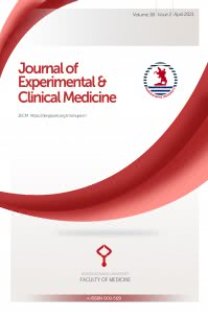Unilateral spinal anesthesia with hyperbaric bupivacaine versus hyperbaric articaine in out-patient knee surgery
Anestezi, spinal, Anestezikler, lokal, Bupivakain, Kartikain, Artroskopi, Ayaktan hasta
Ayaktan gelen diz cerrahisi hastalarında, hiperbarik bupivakain ve artikain ile yapılan tek taraflı spinal anestezinin karşılaştırılması
Anesthesia, Spinal, Anesthetics, Local, Bupivacaine, Carticaine, Arthroscopy, Outpatients,
___
1. Carpenter RL. Caplan RA. Brown DL, et al. Incidence and risk factors for side effects of spinal anesthesia. Anesthesiology 1992; 76: 906-916,2. Simon MA, Vree TB, Gielen MJ, Booij LH. Ccmparison of the effect and disposition kinetics of articaine and lidocaine in 20 patients undergoing intravenous regional anaesthesia during day case surgery. Pharm World Sci 1998; 20: 88-92.
3. Meyer J, Dİetmar E.. Malthias P. Unilateral spinal anesthesia using low-flow injection through a 29-gauge quinke needle. Anesth Analg 1996; 82: 1188-1191.
4. Pittoni G, Tnfibletto F, Calcarella G. et al. Spinal anesthesia in outpatient knee surgery: 22-gauge versus 25-gauge sprotte needle. Anesth Analg 1995; 81: 73-79.
5. Casati A, Fanelli G, Cappelleri G, et al. Effects of spinal needle type on lateral distribution of 0.5% hyperbaric bupivacaine. Anesth Analg 1998; 87: 355-359.
6. Tanasichuk MA. Shultz EA. Matthews JH. et al. Spinal hemianalgesia: an evaluation of a method, its applicability and influence on the incidence of hypotension. Anesthesiology 1961; 22: 74-85.
7. Casati A, Fanelli G, Berti M, et al. Cardiac performance during unilateral lumbar spinal block after crystalloid preload. Can J Anaesth 1997; 44: 623-628.
8. Esmaoğlu A, Boyacı A, Ersoy O. et al. Unilateral spinal anesthesia with hyperbaric bupivacaine. Acta Anaesthesiol Scand 1998; 42: 1083-1077.
9. Cowan A. Clinical assesment of a new local anesthetic agent-carticaine, Oral Surg Oral Pathol 1977; 43: 174-180.
10. Hauenschild E. Central nerve blocks 2000 spinal anaesthetics with carticaine 5% heavy. Anaesthesist 1977; 26: 398-402.
- ISSN: 1300-2996
- Yayın Aralığı: Yılda 4 Sayı
- Başlangıç: 2018
Deneysel korozif özefagus yanığında lipid peroksidasyon, glutatyon ve total tiol düzeyleri
RAMAZAN AMANVERMEZ, Faruk KAZANCI, Cemil ÇELİK, Muhlise ALVUR, Müşerref BOSTANCI
Bronkojenik kist: Olgu bildirimi
Ömer ETLİK, Kürşat UZUN, Mehmet GENCER, Osman TEMİZÖZ, Mehmet Emin SAKARYA
Göknur TARIM, Tayyar CANTÜRK, Nilgün ŞENTÜRK, Ahmet Y. TURANLI
Zafirlukast'ın hiperplastik rino-sinüzite etkisi
M. Levent ERKAN, Serhat FINDIK, Oğuz UZUN, Atilla G. ATICI, Hüseyin AKAN
NURTEN KARA, Hasan BAĞCI, Recep SANCAK
İntrahepatik kolestaz ile seyreden büyük hücreli-immünoblastik lenfoma vakası
İdris YÜCEL, Cem ŞAHAN, Ertuğrul GÜNER, Tanja ÜÇER, Melda DİLEK, Levent YILDIZ
Karadeniz Teknik Üniversitesi Tıp Fakültesinden mezun olacak öğrencilerin gelecek kaygıları
Gamze ÇAN, Mehmet KAPUCU, Hakan TÜRK
Binnur SARIHASAN, Sibel BARIŞ, Deniz KARAKAYA, Ayla TÜR, Fuat GÜLDOĞUŞ, Birol GÜLMAN
